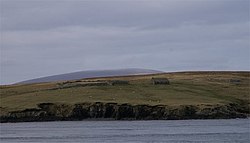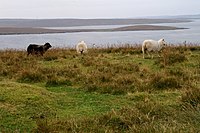Bigga
| Bigga | |
 Bigga | |
|---|---|
| Location | |
| Location: | 60°30’0"N, 1°11’24"W |
| Grid reference: | HU444792 |
| Area: | 0.3 square mile |
| Highest point: | 112 feet |
| Data | |
| Population: | uninhabited |
Bigga is an uninhabited island of Shetland lying in the Sound of Yell between the Mainland and Yell.
Bigga is over 1,000 yards long and a third of a square mile in size, and nowhere exceeds 112 feet above sea level. Bigga is a long thin island with a "head" and a "torso". The neck is formed by the bays of Wester Hevda Wick and Easter Hevda Wick, "hevda wick" being an anglicisation of the Norn (Old Norse) for "seaweed bay". The name of the island itself is the Old Norse Bygdey, meaning "Building Island"; which building is referred to we do not know.
Cattle and sheep were formerly farmed here.
The island is split between the parishes of Delting, and Yell.[1]
Bigga consists of Moine bedrock of coarsely-crystalline gneiss and quartzite.[2]
History
The island is now uninhabited, but it was not always so. In the southern part of the island, there is an old well, chapel and burial ground. There is a small prehistoric cairn in the north of the island. In the north is the remains of Norrabister, the island's "settlement".
The Pribislaw, a 160-year-old German sailing vessel ran aground here in 1870. She had been one of many sailing boats that took German emigrants from Hamburg to Victoria in Australia, around the middle of the 19th century. Moved to Lerwick, she was used as a store and workshop until the 1950s. In 2005 the remaining timbers were excavated and transported to Whittlesea, Australia.[3]
During the Second World War, two sailors from neighbouring Yell wanted to return to their native island to celebrate Christmas during their shore leave. The weather was stormy and snowy and the usual ferry between the Mainland and Yell was not running, so they borrowed a friend's boat. Forced to land on Bigga, they sheltered in the bothy and danced, and played the fiddle in order to stay warm. They managed to reach Yell the next day.[2]
References
- ↑ Bigga Isle
- ↑ 2.0 2.1 Haswell-Smith, Hamish (2004). The Scottish Islands. Edinburgh: Canongate. ISBN 1841954543.
- ↑ "Pribislaw on her last voyage". The Shetland News. February 2005. Archived from the original on 2007-09-27. http://web.archive.org/web/20070927004018/http://www.shetland-news.co.uk/archives/pages/news+stories/2005/02_2005/pribislaw_on_her_last_voyage.htm. Retrieved 2008-01-05.
| Islands of Shetland |
|---|
|
Inhabited islands: |
